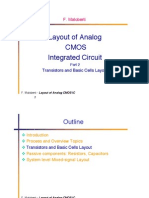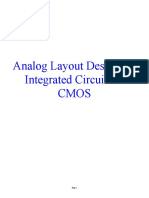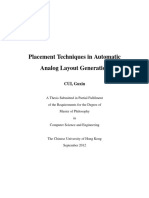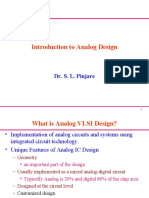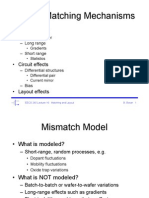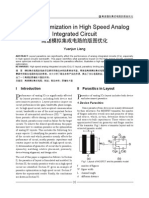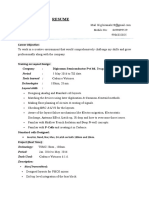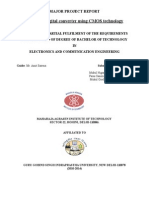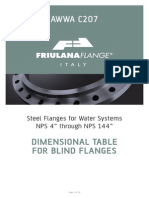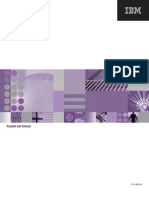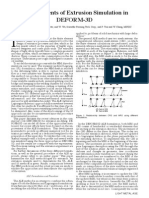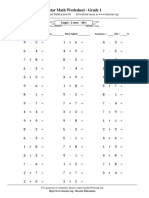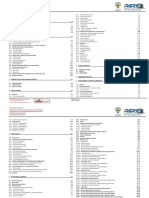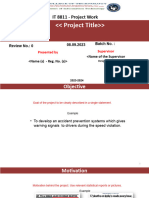ounting on an experienced design team and almost 10 year of track record
with customers around the world, Chipus has developed a large analog
intellectual property (IP) portfolio in technologies from 0.35𝞵m down to
40nm.
The knowledge and experience accumulated along these years enables us to
assist semiconductor companies to successfully launch their innovative
products in the market on schedule.
This document describes how Chipus is able to support you in analog integrated circuit (IC)
layout leading you through our business model, presenting what inputs we expect from you and
what outputs you may expect from us. We also present some success cases to give you
confidence that you have found the right partner.
IC Layout Expertise
General IC Design: Since its inception in 2008, Chipus has been working in complex IC designs,
applying thorough verification with demanding customers around the world. As a result of years
of work, Chipus has built a wide IP portfolio that spans from true ultra-low-power (ULP)
references up to 1.8A power management circuits, high resolution ADC and DACs, sensor
interfaces, and RF front ends to name a few.
Analog Layout: Chipus is able to deliver high quality analog IC layout for different applications in
semiconductor design with the following expertise:
● Low power circuit design ● Experience with automotive layout
● Low noise circuits ● Experience with BCD technologies
● Sensitive analog front-ends ● High current power management
● Mixed signal designs ● High current power devices
● Proven RF capabilities ● MIxed signal IO integration
● Metal-fix strategy ● ESD-aware design
● Spare-cells strategy ● Latch-up-aware design
● Third part IPs integration ● Electromigration-aware design
● Thermal dissipation-aware design
With our layout expertise and proven experience with CMOS and BCD technologies in nodes
from 0.35𝞵m down to 40nm of leading foundries such as TSMC, Global Foundries, XFAB,
For more information visit w
ww.chipus-ip.com or write to s
ervices@chipus-ip.com.
�
TowerJazz, Silterra, AMS, and others, we are able to deliver best-in-class full-custom IC layout
services.
Physical Verification: DRC, LVS, ERC, and antenna are always verified for all circuits layouted by
our team.
Parasitic Extraction: according to customer requirements, Chipus can provide the schematic
back-annotated with parasitics extracted from layout.
Design Complexity: Our technical team is qualified to work with both simple building blocks and
complex chip level designs, being able to provide a verified layout database or GDSII to be
integrated into your SoC or a full chip GDSII ready to be taped out.
ASICs: we have proven experience in delivering full custom IC designs for our customers, which
requires expertise to:
- intelligent floorplanning with attention to sensitive blocks, tracks, and temperature
gradients;
- build IO pad ring, with special attention to foundry rules for voltage supply pads
distribution and mixed digital and analog IO cells;
- deal with multiple supply voltage domains;
- add sealring, dummy metals, dummy diffusion, and dummy poly;
- prepare GDS and tape-out forms for MPW and MLM runs;
- plan reticle for MLM and single mask runs.
EDA: Our team has experience with Cadence and Synopsys tools for analog IC layout design and
Mentor Calibre is our main physical verification tool for signing off all our layouts.
Semiconductor Physics and Fabrication Process: Chipus layout team is composed of Electrical
and Computer Engineers with background in analog IC design, and, hence, have a very good
understanding of the transistor operation, semiconductor physics, and the IC fabrication
process.
For more information visit w
ww.chipus-ip.com or write to s
ervices@chipus-ip.com.
�
Confidential Information
Chipus treats customer information with the same care it handles its own. We take special care
in keeping information contained and our technical team is used to working under these
conditions.
As our main goal is to build long-term relationships, it is important for us that trust is built.
Technical details, business strategies and decisions will not leave Chipus premises.
We normally use our SFTP server to exchange project files and documents with our customers,
ensuring a secure transfer of sensitive information.
Your Layout Project
As matter of quality assurance, evidenced by our ISO 9001:2015 certification, layouts made by
Chipus follow the flow shown below (Figure 1). Chipus IPs go through the exact same process
ensuring high quality designs. Our layout team is always driven by the highest quality standard
in all projects they take in.
Figure 1: Chipus Layout project phases.
For more information visit w
ww.chipus-ip.com or write to s
ervices@chipus-ip.com.
�
Chipus divides the layout project in the following phases:
1. Inputs From Customer
2. Reviews
3. Delivery
As it was mentioned before, confidentiality is an integral part of the process and maintained as
a base throughout all its phases. Let us describe in deeper detail what consists each step, its
inputs and outputs and how it affects the progress of the project.
1. Inputs From Customer
Besides all technical inputs that are required (PDK setup info, schematics, area specifications or
constraints) it is often necessary to discuss other actions associated with business and
technical details that must be taken before the start of the project. Below, we comment the
most important ones.
1.1. Business Model
From our experience, companies often decide to outsource layout when they notice that they
will have problems keeping the schedule. In situations such as this, fast planning and decision
making are mandatory. Chipus is used to this kind of situation and we are able to start the
project right after the paperwork is completed, which can be done in a couple of days.
After taking the decision of involving Chipus in your challenge, the first step is to decide the
most appropriate business model for you. Each customer has its own criteria and Chipus
generally works with:
1. Fixed cost
As the name itself implies, a fixed fee applies for the given project which minimizes the risk for
the customer. A fixed cost approach requires that a project leader from Chipus project is
involved up front to estimate the size of the project. This step is fast and often can be done in a
few days. This celerity is essential to keep up the schedule of the project.
For more information visit w
ww.chipus-ip.com or write to s
ervices@chipus-ip.com.
�
2. Time and materials
This approach provides more flexibility for projects with specifications prone to modifications
with need of reiterative feedbacks. This approach basically adds resources to your layout team
and this additional resource can be in close cooperation with the existing team to ensure
efficient progress.
1.2. EDA Licenses
Chipus normally incorporates EDA license fees into its service offering. Nevertheless, Chipus
has also had successful experiences using customers' infrastructure both remotely and locally
(at the customer site).
1.3. Integration Guidelines
Integration guidelines are requested by Chipus before the beginning of the project to increase
efficiency and reduce the need for unnecessary discussions with the customer. If there are no
specific guidelines from the customer, Chipus will employ its own set of layout guidelines to
ensure that layout best practices are observed.
1.4. Acceptance criteria
Continuous and efficient communication is our main design tool. At the beginning of the project
we will decide the end of project and acceptance criteria along with the customer so that all
expectations are met.
2. Reviews
Each company has design guidelines that they use to ensure quality of their own products. Such
guidelines vary for different circuits: a common building block such as a variable gain amplifier
will use different layout techniques if it is targeted for low noise, high bandwidth or high
accuracy.
For more information visit w
ww.chipus-ip.com or write to s
ervices@chipus-ip.com.
�
In order to ensure that the layout drawn by Chipus captures the design requirements demanded
by circuit designers, we often apply frequent design reviews and an intensive (yet efficient)
communication with the customer.
Our layout team has worked in extreme situations where time constraints left no place for
mistakes and short reviews were made on a daily basis. On the other extreme, we have worked
with customers that requested only one design review before project acceptance. Another
solution already adopted in some projects was to send out the technical team to the customer’s
site to improve communication and speed up project schedule.
3. Deliverables
At the end of the layout project, we deliver to the customer:
1. Complete open access database
2. Extracted views for verification with layout parasitics
3. Physical verification database
4. GDS
Other deliverables may be prepared upon request.
Digital Back-end
Although it is not the focus of this document, it is important to mention that Chipus is also able
to implement digital back-end. This capability enables us to work with more complicated mixed
signal designs or fully digital designs.
Chipus has worked with complex digital implementation in technologies down to leading edge
7nm process featuring around 2.5M placeable cells.
Integration of analog and digital sections can be made both using analog-on-top or
digital-on-top approaches. This depends only on the complexity of the overall design and it is
decided case by case.
For more information visit w
ww.chipus-ip.com or write to s
ervices@chipus-ip.com.
�
Why work with Chipus?
● Chipus works closely to your design team with efficient and continuous communication
● Chipus has an experienced team of motivated semiconductor experts and enthusiasts
● Chipus is almost 10 years in the market with customers in North and South America,
Europe, and Asia
● Chipus is able to support you in your design, either in the development of small building
blocks or in the top level integration of complex chips
● Chipus offers flexible EDA licensing schemes
● From top management to technical team, Chipus is concerned with confidentiality
● Chipus is ISO 9001:2015 certified
Not convinced yet? Please, check some success cases in the last section of this document
and/or schedule a meeting with us.
Full-Custom IC Layout Services Testimonials
Here are some words from customers who valued our service and our Layout Services
specifically. See what they have to say about Chipus’ services and our team.
"Chipus' layout work was performed with high quality and in shortest time and all
our requirements and wishes were fulfilled".
Head of Analog and Mixed-Signal Systems Group
Renowned German Research Institute
“We have a long-term cooperation with Chipus regarding mixed signal design
projects. Chipus helped us out to compensate lacking resources in analog & digital
circuit design, manual chip layout and verification. I can only say that Chipus is a
reliable partner with excellent technical skills and helped us a lot to deal with the
requirements of our demanding and fast changing market today”
Chief Executive Officer
ASIC Company based in Germany
with strong emphasis on automotive
and industrial applications
For more information visit w
ww.chipus-ip.com or write to s
ervices@chipus-ip.com.
�
IPs and ICs Success Cases
Chipus has developed analog integrated circuit layout for its whole IP portfolio and for the ICs
and testchips it has integrated in its almost 10 years in the market. Our layout capabilities are
proven by the successful products that our ASICs and IPs enabled worldwide.
The cases presented here were chosen to demonstrate our layout expertise in different fields of
analog IC design such as:
● Analog front-ends for sensitive signal acquisition
● Custom analog-front ends
● Power management circuits with high current handling capabilities
● Ultra low power circuits
● RF front-ends
Low noise amplifier for neural sensors IC
This design is a low noise amplifier for acquisition of neural signals which are known to be very
sensitive to noise due to their very low amplitude characteristics.
The front-end was designed to match the impedance
of the Silicon Carbide (SiC) electrodes, thus enabling
better neural compatibility of the entire system. Each
stage is capacitively coupled to reduce the offset
around the common mode reference.
Layout technique highlights:
● Low noise
● Fully differential
● Ultra low power
● Intricate matching scheme
The IP core is a 2-stage, 46-dB, fully-differential
amplifier featuring low noise and ultra-low-power
consumption. It was designed in SilTerra 0.18𝞵m CMOS technology. This circuit is silicon
proven and measurements are available upon request.
For more information visit w
ww.chipus-ip.com or write to s
ervices@chipus-ip.com.
�
USB/AC Li-Ion battery charger IPs
These IPs are targeted to SoCs that are used in mobile products such as smartphones, tablets,
and wearables. They were designed for SilTerra 0.18𝞵m CMOS and BCD technologies.
In order to enable charging mode, the IP senses the
temperature of the die, the battery voltage and the supply
voltage. Temperature, over voltage and reverse current
protections are implemented to ensure safe operation of
the battery.
Battery lifetime in maximized with charging modes that are
automatically selected depending on battery voltage. If
battery voltage is too low, trickle charge is enabled: in this
mode a small current is used to charge the battery slowly.
When battery voltage is in a safe region, maximum current
is enabled. When terminal battery voltage is achieved, the
charger is turned into constant voltage mode until the
battery is fully charged. Current is completely cut once the
battery is charged.
Layout technique highlights:
● High current (up to 1.8A)
● High voltage (up to 30V tolerant input)
● DMOS transistors
● Mixed signal design
● Trimmable
These IPs deal with a current of up to 1.8A and special layout techniques were used to ensure
both low drop in the metal tracks and robustness. The newest member of this IP family
(CM1713ff) has built-in USB detection for charging applications and the input is able to deal with
up to 22V.
All battery charger IPs are silicon proven and the latest version has been integrated in a power
management integrated circuit (PMIC) for an european customer that is planned to enter
volume production until the end of 2018.
For more information visit w
ww.chipus-ip.com or write to s
ervices@chipus-ip.com.
�
Full UHF RFID EPC Class 1 Gen 2 and ISO 18000-6C passive tag IC
This ASIC is a complete UHF (860MHz -
960MHz) RFID passive tag IC that
implements EPC gen 2 protocol in SilTerra
0.18𝞵m CMOS. It consists of three main
blocks: i) analog/RF front-end, ii) digital
baseband processor, and iii) non-volatile
memory (NVM).
The analog/RF front-end (CM9011ff) is
responsible for harvesting energy from an RF
signal emitted by an RFID reader, limiting the
input voltage if the RF power is too high, and
for implementing the backscatter
communication. Measurements of the RFID
tags built with this ASIC, whose main design target was area reduction, have shown a read
sensitivity around -12dBm. The chip features a ULP PMU with a power-on reset (POR) circuit,
oscillator and current/voltage references.
Digital baseband RTL was licensed from third party and digital backend was implemented at
Chipus with power optimizations that led to approximately 30% reduction in power. The NVM
was licensed from Synopsys and this success case has been reported in S
ynopsys website.
Chipus has also worked in the design of another RFID tag IC for a Chinese customer to comply
with Chinese RFID standard (GB standard). This improved RFID ASIC has attained a measured
read sensitivity of -17dBm.
Layout technique highlights:
● RF design up to 1GHz ● Integration with third-party IP in ASIC
● Ultra low power ● Trimmable
● Mixed signal project
For more information visit w
ww.chipus-ip.com or write to s
ervices@chipus-ip.com.
�
Custom ASIC for magnetic sensor
This project consisted on the development of an ASIC for a custom magnetic switch sensor.
The customer had developed an innovative magnetic sensor device, based on magnetic
tunneling junction (MTJ) effect, and Chipus developed the ASIC to turn that innovative sensor
into a product. This ASIC implements two types of switches for unipolar and omnipolar modes
of operation. The unipolar switch senses external magnetic field in one direction while the
omnipolar version allows to sense in both directions in the same axis.
The intensity of magnetic field that triggers the switch is configurable through adjustment of
internal bias circuits parameters made during Factory Test Mode. This ASIC consists of i) a
custom analog front-end, ii) an ultra-low-power PMU, iii) LED drivers, and iv) an OTP fuse
memory for production trimming purposes.
This ASIC was developed in TowerJazz 0.13𝞵m CMOS technology. Chipus is a featured
TowerJazz IP partner.
Layout technique highlights:
● Interface with custom sensor
● Mixed signal project
● Integration with third-party IP (MTJ sensor device) in ASIC
● Trimmable
This ASIC is in volume production and it is a successful product developed in close partnership
with the customer.
For more information visit w
ww.chipus-ip.com or write to s
ervices@chipus-ip.com.
�
Galvanically isolated shunt current measurement system
This ASIC was designed for measuring shunt current of high voltage (5kV) power lines. The
system is galvanically isolated and power is transmitted using inductive link integrated in a
System in Package (SiP). It is designed in TSMC 0.18𝞵m and it is now under measurements.
Chipus was responsible for the complete
specification, design, verification and layout of
the chip.
The ASIC features: i) integrated RF rectifier and
RF power amplifier, ii) a linear power
management unit (PMU) and iii) continuous
time 3rd order 64MHz sigma-delta modulator,
iv) analog and digital debug interface.
As power is transmitted through an inductive
link, the rectifier must be able to deal with
25dBm generating an unregulated DC voltage
that varies from 2V up to 3.6V. The PMU is
responsible for generating 1.8V regulated voltage in both analog and digital power domains,
generate voltage and current references and 64MHz clock signal that will be used by the
sigma-delta modulator to sample the input signal. The sigma-delta modulator is sampled at
64MHz and achieves 13 bits ENOB (in simulation) with 50kHz input bandwidth.
Layout technique highlights:
● 2.4GHz RF power transfer
● Different analog power domains
● Integrated high-accuracy ADC
● Trimmable
For more information visit w
ww.chipus-ip.com or write to s
ervices@chipus-ip.com.
�
Foundries
Chipus has close contact with several foundries and is eager to start new cooperations.
About Chipus
Chipus Microelectronics (www.chipus-ip.com) is a semiconductor company focused in the
development of low-power, low-voltage, analog and mixed-signal integrated circuits (ICs) and
systems on chip (SoCs).
Relying on a strong experience in power management and data
converters, the company has more than 150 intellectual property (IP)
blocks in process nodes from 40nm to 0.35𝞵m of various foundries.
Since its foundation in 2008, Chipus has licensed such IPs and provided
associated IC design services with firm commitment and flexible client
support to customers worldwide.
Headquartered in Florianópolis, Brazil, Chipus has a US subsidiary in
Silicon Valley and sales teams in Brazil and Europe.
Bring your challenge to us! Write to services@chipus-ip.com and you will be contacted shortly by
an engineer that will be able to understand your need and give you the appropriate support.
Rua Emílio Blum 131, Torre A, Sala 1006
Florianópolis, SC, 88010-020
Brazil
Phone: +55 48 3365 2740
www.chipus-ip.com/layout-design-services
For more information visit w
ww.chipus-ip.com or write to s
ervices@chipus-ip.com.

